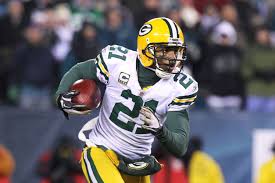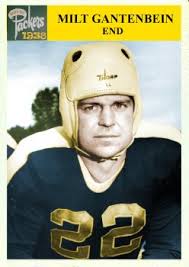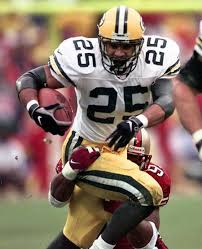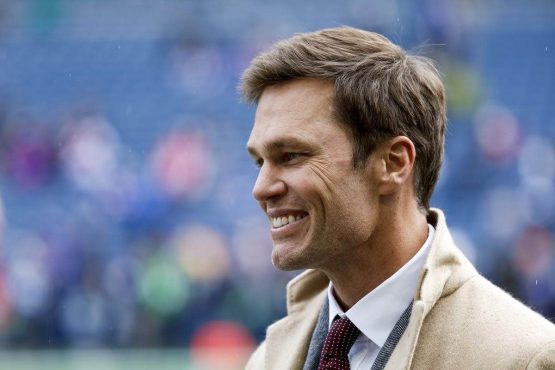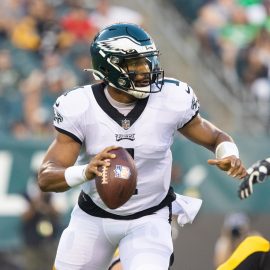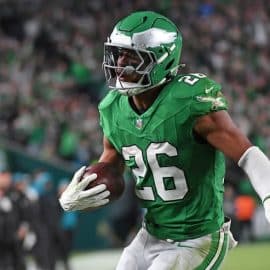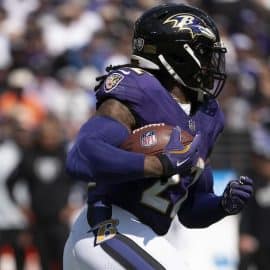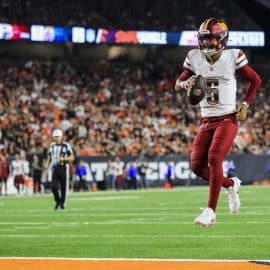This the next in my continuing series of articles of the best Green Bay Packers players of all-time by jersey number. This includes players from all 101 years of Packers football. Over the course of the franchise’s history, some of the greatest players in NFL history have suited up for the Packers and made their mark on the team and the league.
This article will examine numbers 21-25. You can find 1-5 here, 6-10 here, 11-15 here and 16-20 here.
Keep in mind the players are listed by how they performed for the Packers only. Many players wore more than one number during their career. On this list, they are considered primarily for how long they wore each specific number and what they did while they wore it.
When possible, other great players who wore each number will get honorable mention. Feel free to comment and say who you feel belongs on this list.
I will release more articles in this series throughout the offseason.
21. Charles Woodson CB 2006-2012
When the Packers signed cornerback Charles Woodson to a seven-year, $52 million free agent deal in 2006, Woodson was at a crossroads in his career. The former Raiders Pro Bowler had his attitude questioned and his play had fallen off. In addition, he wasn’t thrilled about coming to Green Bay, but he had few other options if we wanted to continue playing football.
But Woodson found his game again and regained his enthusiasm for the game. The former Heisman Trophy winner from Michigan made four consecutive Pro Bowls with the Packers from 2008-2011. Woodson led the NFL in interceptions in 2009 and 2011 and was the NFL’s Defensive Player of the Year in 2009.
During that 2009 season, he intercepted nine passes and returned three of them for touchdowns. In six of his seven seasons in Green Bay, Woodson had at least one pick six and he became a leader in the Green Bay locker room.
Woodson was a big part of the Packers Super Bowl winning team in 2010. He gave a speech after the Packers beat the Bears in the NFC Championship Game that since the president said he won’t go to the Super Bowl if the Bears don’t make it, the Packers will have to just win the game so they can go to him.
Woodson’s injury late in the first half of the Super Bowl helped the Steelers get back into the game, but the Pack held on to win and Woodson won his first Super Bowl championship.
In 2012, Woodson successfully moved from cornerback to strong safety and continued to play well before his season was cut short by injury.
Woodson left the Packers after the 2012 season and finished his career with three more seasons in Oakland.
Woodson will be inducted into the Packers Hall of Fame this spring and is a shoo-in for the Pro Football Hall of Fame.
Other notable Packers to wear number 21 include defensive back Bob Jeter (1963-1970) who played eight seasons and won three championships during the Lombardi Era and is a member of the Packers Hall of Fame, quarterback John Hadl who cost the Packers a bevy of draft picks in the mid-70s and played two seasons with the Pack (wearing 21 for one of them). Also, running back Brent Fullwood who led the Packers in rushing in 1988 and 1989 and made the Pro Bowl in 1989.
22. Milt Gantenbein End/DE (1931-40)
Milt Gantenbein played 10 seasons with the Packers between 1931 and 1940 and was a big part of Green Bay championship teams in 1931, 1936 and 1939.
Gantenbein played his college ball at Wisconsin. He was named to the NFL’s All-Pro Team in 1936 and went to the Pro Bowl after the 1939 season.
Like most players in this era, Gantenbein played both ways. He was the Packers number two receiving threat behind the legendary Don Hutson and 16.9 yards per catch over the course of his NFL career while also playing defensive end.
Gantenbein scored touchdowns for the Packers in the 1936 NFL title game against the Boston Redskins and in the 19439 NFL Championship Game against the New York Giants.
The Packers named Gantenbein their captain in 1937 and he provided the team with outstanding leadership.
After his playing career ended, Gantenbein coached for Manhattan College in New York. He was inducted into the Packs Hall of Fame in 1972 and died at the age of 79 in 1988.
Other prominent Packers to wear number 22 include Packers Hall of Famer Lavvie Dilweg (1927-33) who played on the Packers three straight NFL title teams of 1929-31, cornerback Mark Lee who gave the Packers steady play from 1980-90 and running back Elijah Pitts (1961-69, 71) who won five titles with the Lombardi-Era Packers and scored two touchdowns in Super Bowl I.
23. Travis Williams KR/RB 1967-70
Travis Williams had elite speed and was one of the greatest return specialists in Packers’ history.
The Packers selected “The Roadrunner” in the fourth round of the 1967 NFL Draft. Williams had difficulty with fumbles in training camp and Vince Lombardi told him to carry a football with him wherever he went, even to bed. Eventually, Williams learned how to hold on to the football.
The Arizona State product made in immediate impact as a rookie, averaging 5.4-yards per carry in his first NFL season. But his biggest value came as a return specialist. Williams led the league with a 41.1-yards average per kick return and scored four touchdowns to lead the league in both categories.
In the playoffs that season, Williams had a strong game against the Los Angeles Rams in the opening round. The Rams were 11-1-2 that season while the Packers were just 9-4-1, but Williams gained 88 yards and scored two rushing touchdowns to help lead the Pack to a 28-7 victory.
Williams led the Packers in rushing in 1969 with 536 yards. He remained a return threat and a solid running back during his four seasons with the Packers before being traded to the Rams before the 1971 season.
Unfortunately, Williams struggled with drug addiction and other off the field issues after his playing career ended. He died at the age of 45 in 1991.
Other prominent Packers to wear 23 include end Clyde Goodnight (1945-49) and hard-hitting safety George “Tiger” Greene (1986-90).
24. Willie Wood S 1960-71
When Willie Wood came out of USC in 1960, no NFL or AFL team drafted him. Wood had to write letters to teams asking for a tryout. The Packers signed him as a free agent and he quickly developed into one of the best safeties in the game.
Wood made eight Pro Bowls with the Packers between 1962 and 1970 and was named All-Pro five times.
He led the NFL with nine interceptions in 1962 and finished his 12-year NFL career with 48 interceptions including two pick sixes.
Wood also returned punts for the Packers and scored two touchdowns on punt returns in 1961. He also led the league with a 13.3-yard average in 1964.
In Super Bowl I, Wood made a game-changing interception in the third quarter. The Packers were clinging to a 14-10 lead and the Chiefs had the ball in decent field position and were moving the ball. Lombardi called for a rare blitz on third down and Wood intercepted a Len Dawson pass and returned it 50 yards to the Kansas City 5. Elijah Pitts scored on the next play and the Packers led 21-10. It was the turning point of the game.
After his playing career, Wood became an assistant coach with the San Diego Chargers. He later became a head coach in the WFL and the Canadian Football League becoming one of the first African Americans to be named the head coach of a pro football team.
Wood was inducted into the Packers Hall of Fame in 1977 and the Pro Football Hall of Fame in 1989. He died on February 3, 2020, at the age of 83.
Other prominent Packers to wear 24 included safety Johnnie Gray (1975-83) who provided the Pack with hard hitting and consistent play during Bart Starr’s tenure as coach, and cornerback Jarrett Bush (2006-14) who was a part of the Packers Super Bowl-winning team in 2010.
25. Dorsey Levens 1994-01
The Packers selected running back Dorsey Levens in the fifth round of the 1994 NFL Draft out of Georgia Tech.
Levens gradually gained playing time while backing up Edgar Bennett at halfback during his first three NFL seasons. Levens first big game came in the 1996 NFC Championship Game against the Carolina Panthers when he ran for 88 yards in 10 carries and caught five passes for 117 yards including an acrobatic touchdown that put tied the game at 7-7 early in the second quarter.
In 1997, Levens took over as the starting halfback and gained a career-best 1,435 yards and seven touchdowns. Levens also caught 53 passes for another 370 yards and five touchdowns.
In the playoffs that year, Levens gained more than 100 yards against both the Bucs and 49ers and then added 90 yards on 19 carries in Super Bowl XXXII against Denver.
Levens had another 1,000-yard season in 1999, gaining 1,034 yards and scoring nine touchdowns in just 14 games.
He remained with the Packers through the 2001 season before finishing his career with the Eagles and Giants.
Levens was inducted into the Packers Hall of Fame in 2009. For eight seasons, he gave the Packers versatile performances as a runner and receiver and helped them win Super Bowl XXXI.
Running back Ryan Grant (2007-12) was another prominent Packers player to wear 25 and gained more than 1,200 yards in 2008 and 2009.
Follow Gil Martin on Twitter @GilPackers
Click here for more great Packers coverage
Visit my Web site for all things Gil Martin
Add The Sports Daily to your Google News Feed!
